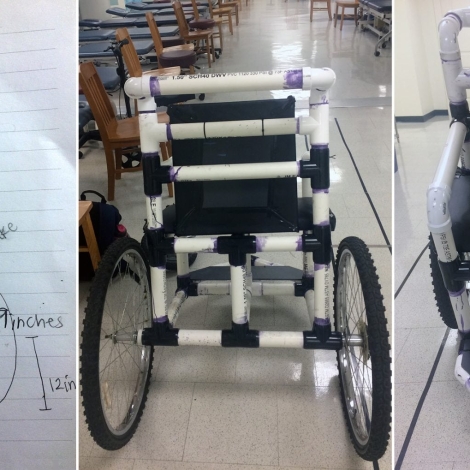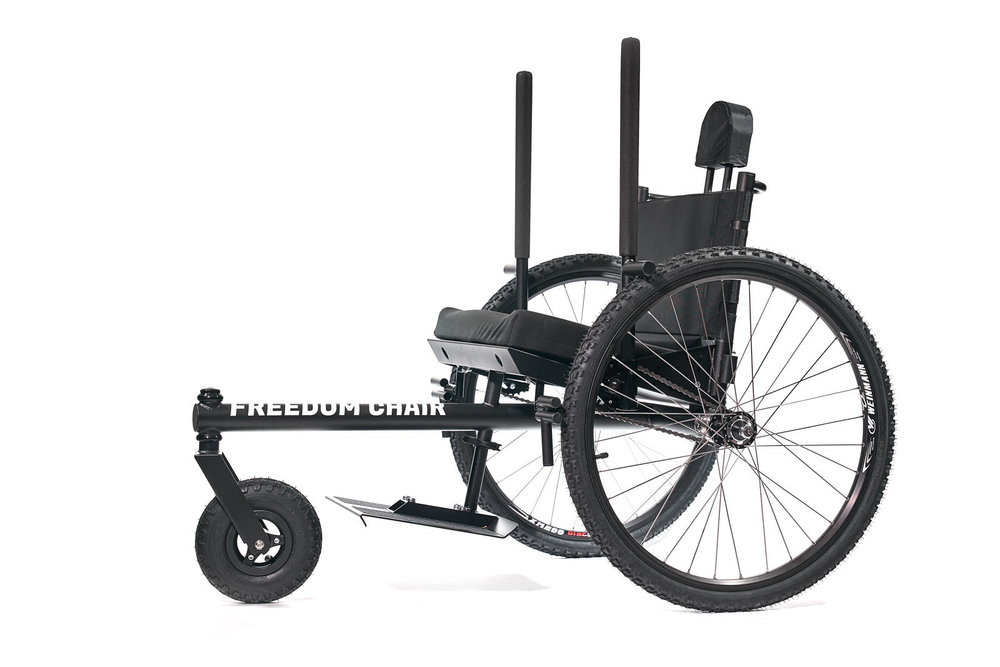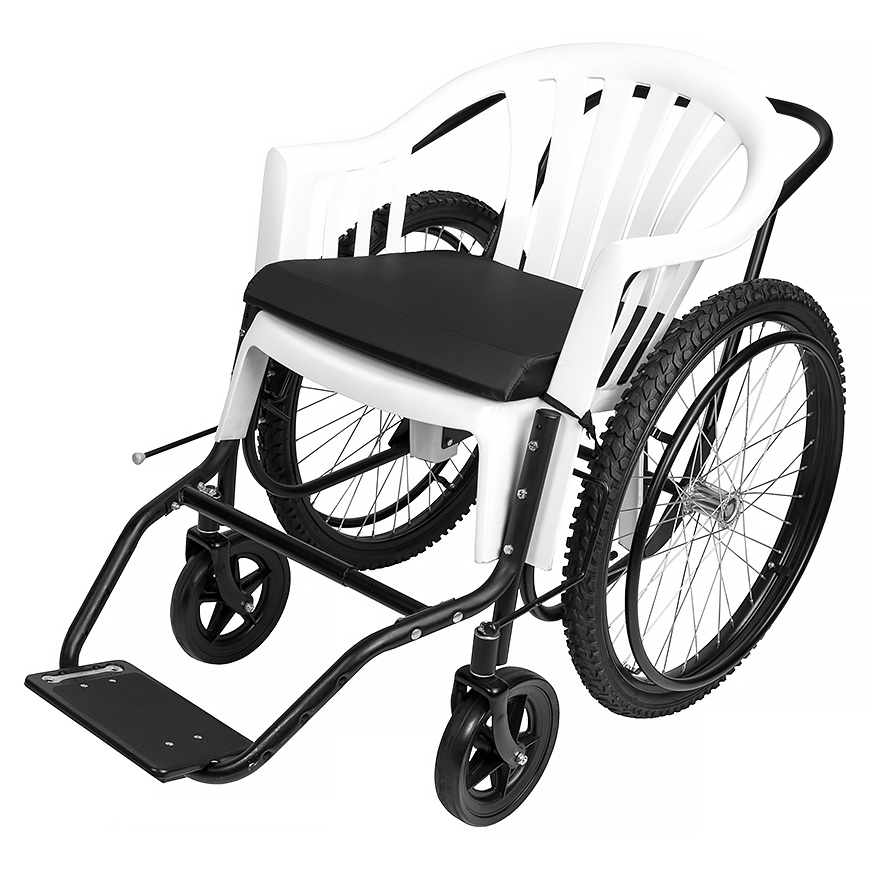Complex challenges await designers developing wheelchairs for low-resource settings, but the result could be life-changing for the people who use the chairs. To help designers create sustainable chairs that last, Engineering for Change’s Research Fellows have compiled a list of considerations for the design, production, and implementation of wheelchairs in places where resources are scarce.
The Challenge and the Need
There is great need for wheelchairs in communities with emerging economies. The World Health Organization (WHO) estimates that only 5—15 percent of people who need assistive devices have access to them in middle- and low-income countries. These regions tend to have a larger disabled population due to current or recent history of war, and the increased rate of growth of their elderly population compared to high-income countries. Also, it is difficult to design new systems for wheelchair production, maintenance, and distribution in these areas because the resources simply may not exist. Instead, some organizations are turning to community-based programs using existing infrastructure as a viable solution. Such programs are underway in some countries, although there is much left to be done to bridge the gap between wheelchair availability in high-income countries compared to that of low- and middle-income countries.
It is difficult to design new systems for wheelchair production, maintenance, and distribution in these areas because the resources simply may not exist.
Although there may be an abundance of wheelchairs in high-income countries, many of them are unaffordable for those in low-income countries, and shipping them would not be feasible. Indeed, even if chairs were shipped, their developed-world designs may be a liability in low-resource settings. It has been estimated that 40 percent of donated medical equipment goes unused in low-resource settings due to the lack of infrastructure to maintain such devices.
The advice and resources below can help designers navigate these challenges.
Building Methods
Designers must determine the most efficient and least costly means of manufacturing the chair. The options are manufacture in the country where it will be sold, or manufacture abroad, or a piecemeal hybrid in which some parts are manufactured locally and others abroad. To determine the best manufacturing pathway for a specific environment, designers must communicate with health clinics and other partner organizations. They need to understand what materials are readily available. They should also collect information on the local availability of skilled mechanics, technicians, and workshops. To prevent complications later, the manufacturing pathway should be determined before design of the wheelchair commences.
Biomechanical Considerations and Standards
As with all wheelchairs, the chair must be safe, physically comfortable, and prevent overuse or stress on any area of the body. Designers should consult with a physical therapist or wheelchair biomechanics expert to design a wheelchair that will not cause injury or overtax the body. Biomechanical considerations include, but are not limited to, breakdown of skin at the contact point with the wheelchair, the angle at which the hip joint reaches when seated, the distance of the tire from the patient’s hand, the angle at which patient’s shoulder must rotate to propel forward for long distances, and amount of mobility and dexterity required to exit and enter chair. The chair should be able to handle a heavy person from the country of need, with an added factor of safety.
It is good practice to produce multiple iterations of a prototype before bringing a chair to market.
It is good practice to produce multiple iterations of a prototype before bringing a chair to market to ensure that the chair is mechanically sound and user friendly. It may be helpful to use these standards below and reference the “functional performance” section of this guide when testing the chair.
- Developing product quality standards for wheelchairs used in less-resourced environments (wheelchairnetwork.org / African Journal of Disability)
- Guidelines on the provision of Manual Wheelchairs in less-resourced settings (WHO)
A full list of the ISO standards for wheelchairs can be found in the ISO catalogue. It is always beneficial to adhere to ISO standards when designing a product, but when designing such a niche product, it is not always feasible.
Materials and Testing
The chair must be made from materials that are appropriate for the climate and environment where it will be used. This includes avoiding metal when designing for humid climates to avoid rust, and using strong, wear-resistant materials if the terrain is rocky. Automobile transportation may not be the preferred way to travel in many low-resource settings. Because walking replaces traveling by automobile in many parts of the world, a wheelchair must be resilient and comfortable enough to navigate bumpy terrain while covering a substantial distance. “Substantial” may be an ambiguous term, but for reference, the Office of the United Nations has estimated that the average woman in Africa and Asia walks six kilometers for water every day. The wheelchair user may not be the one collecting water, but navigation around the community is most likely needed. Once the materials and design are determined, it is ideal to test the chair in a CAD program before building to make sure that the chair can support 25, 50, 75, and 100kg, along with a factor of safety, representing the weight range from child to large adult.
Maintenance
Replacement components must be available in country if the user needs support. Generally, tires and seats are the two most often replaced parts of a wheelchair. Therefore, these two parts take priority in plans to manufacture either locally or abroad. In order to successfully maintain wheelchairs, a wheelchair repair technician must be on-hand in the country. Access to technical support is often a road block in low-resource settings. To mitigate this challenge, the WHO is working to provide regional and country workshops on facilitating assistive device access, although often basic bicycle repair shops will be able to do the repairs assuming they have the components at hand, including tires, as mentioned above.
Cost Considerations
The wheelchair must be cheap enough to be purchased by users (if using market price), or by health clinics if a subsidy model is used. This is a straightforward concept, but is nonetheless essential. If the user cannot afford the chair, the chair will not have much impact. For reference, The World Bank has determined that low-income economies had a gross national income of (USD) $1025 or less in 2015, and lower-middle-income economies are those with a GNI per capita of $1026 – $4035. Health clinics, NGOs, and other organizations may be able to fully or partially subsidize the cost of the wheelchair.
Cultural Idiosyncrasies
Finally, designers should address cultural idiosyncrasies and adjust the wheelchair accordingly. For example, the average person in the intended market may be either lighter or heavier than the average person of the country where the chair is in development. Also, homes, and door frames in particular, in developing countries may measure smaller than the average US homes and door frames. Designers should dimension the chairs to fit in the places where it will be used in the intended market. The chair should also be safe to seat much more than the average person’s weight in its market. Communication with in-country health clinics and governments is critical to ensure a culturally sensitive wheelchair design.
Service Delivery and Funding
Once the designer has produced multiple iterations and brought the wheelchair to market, the recipients, be they health clinics, government, community organizations, orthe designer him or herself must determine how they want to distribute the chairs. The designer may or may not be involved in this part of the supply chain. But keep in mind that how a product is distributed may matter more than the product itself.
Keep in mind that how a product is distributed may matter more than the product itself.
Sources of funding are crucial, even for the cheapest wheelchair, as many still may not be able to afford it. First, the total cost of the chair, shipping costs, technical support services and clinic visits per patient must be estimated. Sources of funding include government funding, donor funding, NGOs and others. Many funding systems for health products in developing countries work by partially subsidizing the cost of the product based on the user’s income.
Patient and provider education is also critical to ensure that wheelchairs not only reach the patients that need them but are also used properly. Potential users may contact the wheelchair service directly or be referred through government and non-government-related health and rehabilitation workers.
The health clinics will often assess a patient’s needs, determine if a given wheelchair is appropriate for the patient, train the patient or caregiver in wheelchair use, and provide continuing technical support, often through workshops and mechanics (see the WHO’s wheelchair guidelines linked above). It is considered good practice to include user manuals and pamphlets with the wheelchair. Also, it is helpful to provide the wheelchair provider (health clinic, wheelchair center) with a manual on effective provision of services and chair. Along with users, caregivers and family members must be trained in helping the user transfer into and out of the chair, how to handle the wheelchair, basic wheelchair mobility, and prevention of pressure sores, among other things. Specialized wheelchair services, centers and health clinics, along with basic community services (bike shops, basic workshop facilities) can be used in harmony to create a smooth service delivery. The main roles involved in service and delivery are the manufacturers and wheelchair suppliers, those who refer patients to the wheelchair center, and the service team members (caregivers, prescription makers, training staff, maintenance staff).
For more, please see E4C’s online course that offers practical steps to distribute and scale your technology.
Wheelchairs Currently on the Market—How They Did It
Let’s take a look at two wheelchairs currently on the market in developing countries.
First up is the Leveraged Freedom Chair (LFC) designed by the MIT Mobility Lab and Amos Winter. The LFC is designed using steel and bicycle parts, which are widely available around the world and in developing countries. This enables easy repairs. The chair is also designed with hand levers to travel long distances- manufacturer targets are to travel 5km per day on variable terrain. LFC kits are manufactured and sent to local in-country workshops for assembly. Before bringing the chair to market, the GRIT (formerly MIT Mobiity Lab), conducted field tests in India, Kenya, Guatemala, and Haiti. Once the chairs proved to be functional and meet the designer’s standards, the chairs were able to be brought to market. The LFC is sold in bulk to government and non-government organizations working to try to better the lives of the disabled in developing countries. These organizations then distribute the chair to users in need, after consulting the LFC’s prescription checklist to determine if the LFC is the right wheelchair for the patient. The chair meets ISO standards.
Second, let’s look at the GEN_1 chair by Free Wheelchair Mission (FWM). The Gen_1 is built for basic mobility and for use on rugged terrain. The chair consists of a steel frame with an injection-molded polypropylene resin chair (a basic plastic lawn chair). The materials are universally available. FWM partners with local charitable organizations that act as distribution partners. Similar to the Leveraged Freedom Chair, kits for the GEN_1 are mass produced and sent to RC for hand assembly by distribution partners. FWM also provides an assembly video to assist distribution partners. Durability testing of the chair is done at the manufacturing facility, and field tests have been conducted by a university physical therapy department in India and Peru. These partners locate and determine qualified persons in need. They are trained through FWM’s “Leading Partner Program” in wheelchair provision from prescription and fitting through user training, although users are provided with a manual on maintenance and use. It is estimated that each chair costs roughly (USD) $72, including manufacturing, shipping, and distribution costs. The cost of the chair is completely borne by FWM and the partners, making the chairs free to those in need. Distribution partners are available for repair and assistance, although replacement components for the GEN_1 are available worldwide. Users are provided with a basic repair kit and contacts for maintenance assistance.
Both the Leveraged Freedom Chair and the GEN_1 use materials easily transportable to the RC and have set up supply chains with NGOs, government organizations, and distribution partners to take care of things like assembly and service delivery. Both designers have made sure that replacement components are available in country and that the chair is strong enough and suitable for the user’s needs based on the terrain and climate of the RC. The LFC and GEN_1 were both field tested before being brought to market and service delivery and funding was determined, with government and non-government organizations either fully or partially subsidizing the cost to the user.
In conclusion
It takes effort and time to design a chair that is comfortable and well adapted to the unique circumstances in its intended market. But putting work into research, prototyping and testing can increase the likelihood that a chair reaches the people you want to help, and that it serves them for years, or even a lifetime. If you take one thing from this essay, let it be that the comfort and dignity of the person who uses the chair is paramount. But your work is wasted if costs are too high, spare parts are inaccessible, and hitches in distribution prevent the chair from ever reaching those who need it.



